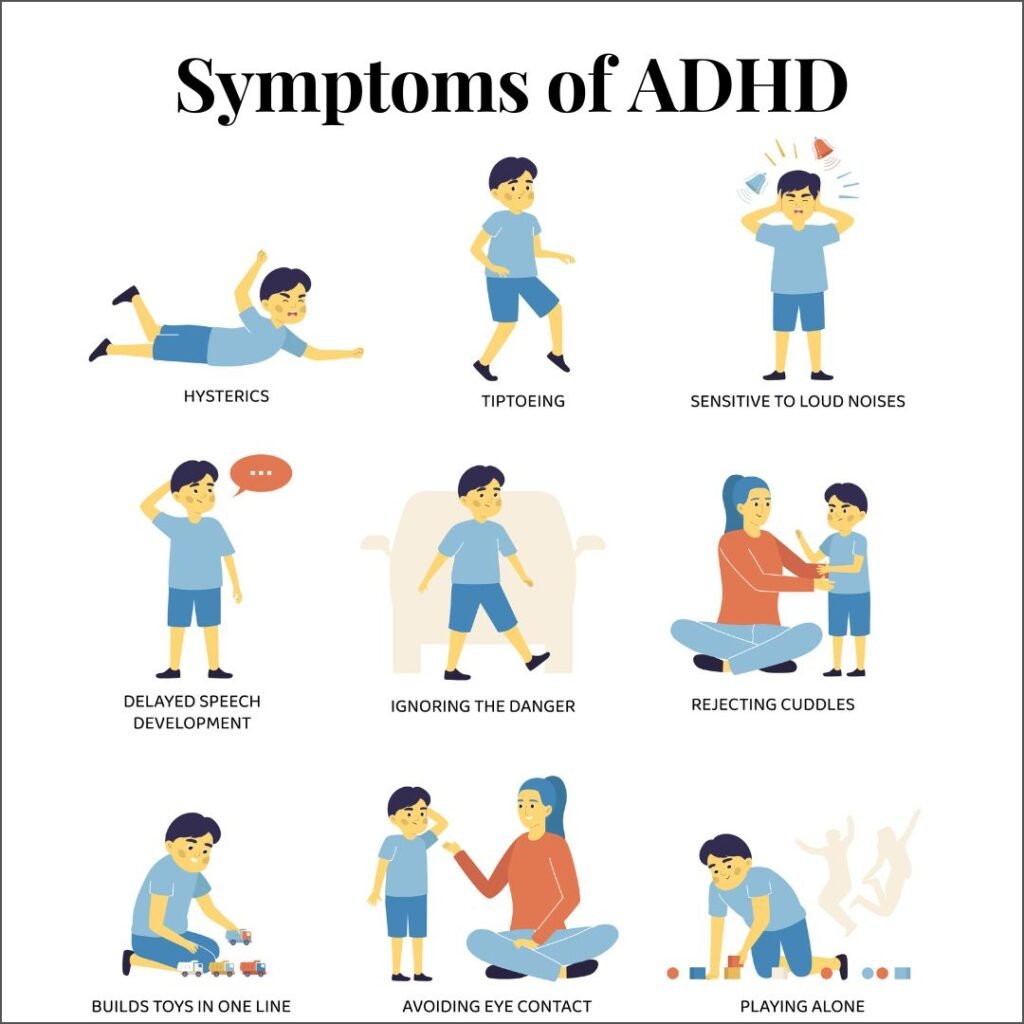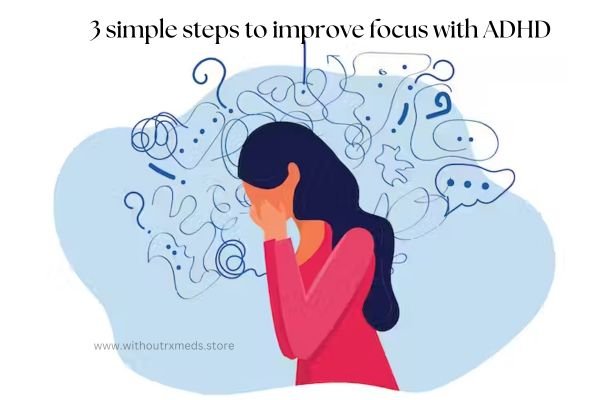3 Simple Steps to Improve Focus with ADHD
Living with attention deficit hyperactivity disorder (ADHD) entails some challenges mainly on the focus front and productivity while working. Attention can be captured by so much distraction, with difficulty in prolonging it – this can even feel overwhelming most of the times. However, there are simpler strategies that truly make a huge difference. So here are the three simple effective steps to bring improvement in concentration with ADHD with easy navigation daily tasks.
What is ADHD?
Attention Deficit Hyperactivity Disorder (ADHD) is a chronic condition that affects how a person thinks, behaves, and interacts with the world. It is a neurodevelopmental disorder, which means it arises from differences in brain development and function. People with ADHD often experience challenges in managing attention, controlling impulses, and regulating activity levels. These difficulties can cause problems in school, at work, and in personal relationships.
Symptoms of ADHD

The symptoms of ADHD can be grouped into two main categories: inattention and hyperactivity-impulsivity. However, people with ADHD may experience these symptoms in different combinations, which is why ADHD is divided into three subtypes:
1. Inattention
People with ADHD who primarily struggle with inattention may exhibit the following behaviors:
- Difficulty staying focused on tasks or activities
- Frequent mistakes due to a lack of attention to detail
- Avoidance of tasks that require sustained mental effort (e.g., homework, reading)
- Difficulty following instructions and completing assignments
- Frequently losing items such as keys, books, or tools
- Easily distracted by irrelevant stimuli (e.g., noises, conversations)
- Forgetfulness in daily activities (e.g., missing appointments)
2. Hyperactivity-Impulsivity
People with ADHD who are primarily hyperactive or impulsive may show these behaviors:
- Restlessness or fidgeting (e.g., tapping hands or feet)
- Inability to sit still, especially in situations where it is expected (e.g., in a classroom or meeting)
- Talking excessively or interrupting others
- Difficulty waiting for their turn in activities or conversations
- Acting without thinking, leading to impulsive decisions or risky behavior
- Interrupting others’ conversations or games
3. Combined Type
In many cases, individuals with ADHD exhibit a combination of both inattention and hyperactivity/impulsivity. This is the most common form of ADHD, where symptoms from both categories are present.
Causes of ADHD
While the exact cause of ADHD remains unclear, there are several factors believed to contribute to the disorder. These include:
- Genetics: ADHD tends to run in families, suggesting a genetic link. Research shows that certain genes involved in the regulation of neurotransmitters like dopamine may be associated with the disorder.
- Brain Structure and Function: Brain imaging studies have shown that people with ADHD may have differences in the size and activity levels of certain brain regions involved in attention, impulse control, and executive functioning.
- Prenatal and Early Life Factors: Exposure to certain environmental factors during pregnancy, such as tobacco smoke, alcohol, or drugs, can increase the risk of developing ADHD. Premature birth and lead exposure are also potential risk factors.
- Neurochemical Imbalance: ADHD has been linked to imbalances in brain chemicals, particularly dopamine, which plays a role in attention and reward processing.
Impact of ADHD on Life
ADHD can significantly affect a person’s life, especially if left untreated. Individuals may face challenges in their academic performance, work life, social interactions, and emotional well-being. In children, untreated ADHD can lead to academic underachievement, poor self-esteem, and difficulties with peer relationships. In adults, it may result in problems with job performance, maintaining relationships, and managing daily responsibilities.
3 Simple Steps to Improve Focus with ADHD
Attention deficit hyperactivity disorder (ADHD) is a condition that burdens millions of people and makes it hard to focus, organize, and follow through with what needs to be done. Whether as a student, employee, or person managing everyday life, staying focused can sometimes feel like trying to climb a steep mountain. But need not fear-improving focus with ADHD is not an impossible task!
While ADHD indeed brings along individual challenges, various proven strategies aid in improving attention, reducing distractors, and enhancing productivity. You can even break down an overwhelming task as big as it is to step-by-step development to help you master some of its differences in the daily scheme of life. Here at this blog are three simple action steps to easily improve anyone with ADHD’s focus concentration.

Step 1: Prepare a Structured Environment
The best way to enhance concentration is by establishing an organized environment with minimal distractions. People with ADHD find it challenging to concentrate in a disorganized or chaotic setting. Thus, creating a conducive environment for concentration is necessary.
How to Create a Focus-Friendly Environment:
a. Declutter Your Space: A cluttered workspace can be overwhelming and distracting. Take time to tidy up your environment and remove unnecessary items that could pull your attention away from your tasks. This might mean clearing off your desk, putting away extra papers, or organizing your workspace into designated areas for specific activities.
b. Utilize Visual Cues: Incorporate visual reminders of the tasks you need to focus on. Do this by writing important tasks on a whiteboard or even sticky notes to place within your line of sight. In this way, you’ll always have a visual cue on what the next task to focus on should be.
c. Control External Distractions: If you’re working in a noisy environment, consider using noise-canceling headphones or playing calming background music that helps you concentrate. If possible, limit distractions by turning off notifications on your phone or computer. Using apps like “Focus@Will” or “Forest” can also help create a productive sound environment.
d. Set a specific workspace: If possible, designate a specific area for work or studying. Having a “work-only” space can condition your mind to associate that area with focus and productivity. When you sit down in this space, your brain will start preparing for concentration, making it easier to get into a productive mindset.
Step 2: Break tasks into smaller, manageable steps
Individuals with ADHD also have difficulty when it comes to handling large, overwhelming tasks. The thought of having to accomplish a big project or long list of to-do things is just too burdensome, often resulting in procrastination or mental burnout. One effective way to maintain focus is to help oneself break up big tasks into manageable steps. In this way, you have a good direction and can drive your motivation as things get done.
How to Break Work into Smaller Steps:
a. The Pomodoro Technique: It is a time management technique by which you split work into 25-minute increments, followed by short 5-minute breaks. This technique allows for the management of distractions and structures your time to keep you focused in short bursts. After four “Pomodoros,” you take a longer break of 15-30 minutes to recharge.
b. Set Clear and Attainable Goals: Instead of starting with a vague goal such as “Write a report,” break it down into specific steps. For example:
- Outline the report
- Research necessary information
- Write the introduction
- Write each section one by one
- Proofread and finalize By breaking it down this way, each task seems more attainable, so the feeling of “too much to do” dissipates.
c. Use a Task Management System: Whether you rely on a to-do list app, a planner, or sticky notes, use a system that works for you to keep track of your tasks and deadlines. Apps like Todoist, Trello, and Asana are great tools for breaking up those big tasks into smaller pieces and setting reminders. Organize the tasks by importance and deadlines, checking off completed steps to keep yourself motivated.
d. Set a time block for each activity you have to do: For instance, “I will work on this report for 30 minutes and take a 10 minute break.” Through time blocking, one is able to maintain structure and concentration on doing one thing at a time instead of heaping everything going on in your mind.
Step 3: Institute Regular Routines and Breaks
ADHD often causes difficulty with maintaining focus over long periods. People with ADHD may find it hard to stay focused for extended stretches without experiencing a mental “block” or burnout. Implementing regular routines and breaks can greatly improve focus, productivity, and mental well-being.
How to Implement Effective Routines and Breaks:
a. Establish a consistent daily routine: People with ADHD are more comfortable if they have a routine that can give them a structure to their day. Predictability reduces the cognitive load associated with deciding what to do next and decreases distractions. Wake up, work, and rest at the same time every day to help create balance and stability.
b. Time Your Breaks Strategically: Working or studying in long stretches without taking breaks always leads to a declination of focus. Schedule regular breaks throughout the day so that your brain gets an opportunity to recharge. If you’re using the Pomodoro Technique, this is just part of the cycle with breaks built right into your workflow.
c. Move Around: Try to fit in some movement during your breaks. Stretching, walking, or even doing light exercises can help increase blood flow to your brain and refresh your focus. Some people with ADHD use a standing desk or, indeed, walk while brainstorming or working on less demanding tasks.
d. Practice Mindfulness: Mindfulness exercises, such as deep breathing or meditation, can help you ground yourself and improve focus. Taking a few minutes to reset can reduce stress and mental fatigue, making it easier to dive back into tasks. Apps like Headspace and Calm offer guided mindfulness sessions tailored to short bursts of time.
e. Use “Transition Routines“: When switching between tasks, institute simple transition routines. As you’re wrapping up a meeting and are about to work, for instance, spend a few minutes cleaning up your space, deep-breathing, and refocusing your thoughts. These rituals allow your brain to understand it is time to refocus.
Conclusion: Habits for Focusing with ADHD
Improving concentration with ADHD is not about being perfect; it is about developing a consistent habit that works for you. A structured environment, breaking tasks into smaller steps, and developing regular routines and breaks can go a long way in improving focus, productivity, and the management of ADHD.
Remember, it is not your intelligence or your potential that reflects ADHD; it’s just the way your brain functions. The best strategies, little trial and error, can get you the right tools to work effectively with your focus and excel in personal as well as professional life.
Focus is a skill that can be improved, even with ADHD. Embrace these steps, give yourself patience, and keep experimenting with what works. Over time, you’ll start seeing more focus, better productivity, and a greater sense of accomplishment.






